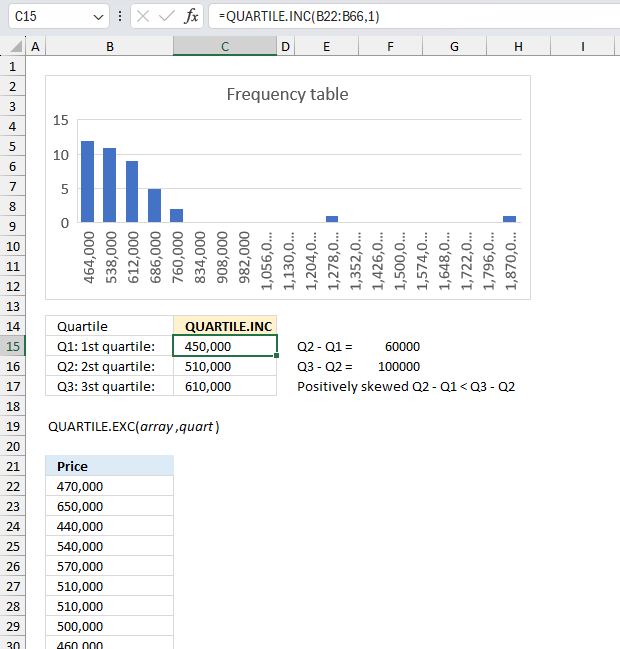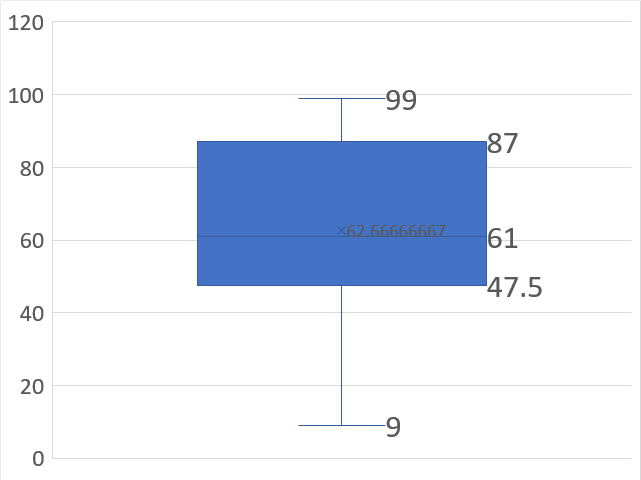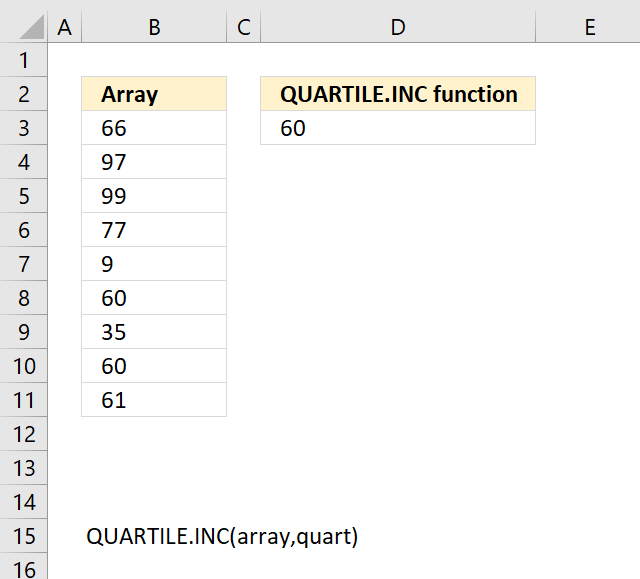How to use the QUARTILE.INC function

What is the QUARTILE.INC function?
The QUARTILE.INC function returns the quartile of a data set, based on percentile values from 0..1, inclusive. Use the Quartiles.inc function to divide numerical values into groups. This function has replaced the old QUARTILE function
Table of Contents
1. Introduction
What is QUARTILE.INC an abbreviation from?
QUARTILE.EXC is an abbreviation of QUARTILE INCLUSIVE.
What is a quartile?
A quartile is a type of quantile which splits a dataset into four equal parts. The quartiles divide a rank-ordered dataset into four quarters.
There are three quartile values - Q1, Q2, and Q3:
Q1 (first quartile) - 25th percentile
Q2 (second quartile) - 50th percentile (median)
Q3 (third quartile) - 75th percentile
What is the interquartile range (IQR)?
The interquartile range (IQR) is the difference between Q3 and Q1. It indicates the middle 50% spread of the data.
When is it useful to calculate the quartiles?
Quartiles provide quantile-based partitioning of data that reveals distribution, spread, skewness, and outliers. They serve as an important basic statistical summary.
Symmetrical distribution: Q2- Q1 =Q3- Q2
Positively skewed: Q2- Q1 < Q3- Q2
Negatively skewed: Q2- Q1 > Q3- Q2
Learn more about skewness: SKEW function
What is quantile?
Quantiles are a statistical technique for dividing a dataset into equal-sized groups for analysis. Quantiles split data into equal-sized subsets when ordered from smallest to largest.
The quartiles, percentiles, quintiles, deciles, etc. are examples of quantiles.
- Quartiles split data into 4 equal groups
- Percentiles into 100 groups,
- Quintiles into 5.
Quantiles can show aspects of shape, spread, and concentration.
How to graph quartiles?
The Box and Whisker chart display quartiles.
2. Syntax
QUARTILE.INC(array, quart)
| array | Required.The cell values for which you want to calculate the quartile value. |
| quart | Required. Indicates which value to return. |
| Quart parameters | |
|---|---|
| 0 | Minimum value. |
| 1 | First quartile (25th percentile). |
| 2 | Median quartile (50th percentile). |
| 3 | Third quartile (75th percentile). |
| 4 | Maximum value. |
3. Example 1
The image above shows a data set in cell range B3:B11 and a formula in cell D3. The data in B3:B11 contains 9 values and they are:
| Array |
| 66 |
| 97 |
| 99 |
| 77 |
| 9 |
| 60 |
| 35 |
| 60 |
| 61 |
The formula in cell D3 calculates the 1st quartile (inclusive) based on the values specified in B3:B11.
Formula in cell D3:
The formula returns 60 which represents the first quartile. The first half of numbers are: 9, 35, 60, 60, and 61. The median number is 60 which is the first quartile. 61 is the median and is also included in the calculation hence the name QUARTILE.INC meaning inclusive.
4. Example 2

In a manufacturing process, the weight of products is closely monitored for quality control. Is the distribution of weights skewed?
The data set is in cell range B22:B66.
| 47 | 51 | 43 | 70 | 50 | 49 | 53 | 52 | 43 |
| 65 | 4 | 68 | 66 | 30 | 43 | 61 | 34 | 25 |
| 44 | 51 | 67 | 44 | 50 | 55 | 71 | 44 | 43 |
| 54 | 50 | 61 | 72 | 47 | 59 | 87 | 67 | 40 |
| 57 | 46 | 49 | 45 | 56 | 54 | 61 | 39 | 40 |
This formula calculates the first quartile (Q1). Formula in cell C15:
This formula calculates the second quartile (Q2). C15 returns 44. Formula in cell C16:
This formula calculates the third quartile (Q3). C16 returns 50. Formula in cell C17:
C17 returns 61.
Positively skewed meets the following condition Q2 - Q1 < Q3 - Q2
Negatively skewed meets the following condition Q2 - Q1 > Q3 - Q2
Symmetrical distribution: Q2 - Q1 = Q3 - Q2
Q2 - Q1 = 50 - 44 = 6
Q3 - Q2 = 61 - 50 = 11
6 < 11 which means that the distribution is positively skewed, however, the frequency table above shows that the distribution is negatively skewed meaning the tail is longer on the left side. This is one of the downsides with calculating the quartile skewness, outliers may create problems. The SKEW function calculates a more accurate skewness value than the quartile skewness value.
5. Example 3

A real estate agent wants to analyze the distribution of home prices in a particular neighborhood. How can they use quartiles to understand the spread of prices, identify any skewness in the distribution, and detect any outliers that may represent unusually high or low-priced properties?
This formula calculates the first quartile (Q1). Formula in cell C15:
This formula calculates the second quartile (Q2). C15 returns 450,000. Formula in cell C16:
This formula calculates the third quartile (Q3). C16 returns 510,000. Formula in cell C17:
C17 returns 610,000.
Positively skewed meets the following condition Q2 - Q1 < Q3 - Q2
Negatively skewed meets the following condition Q2 - Q1 > Q3 - Q2
Symmetrical distribution: Q2 - Q1 = Q3 - Q2
Q2 - Q1 = 510,000 - 450,000 = 60,000
Q3 - Q2 = 610,000 - 510,000 = 100,000
60,000 < 100,000 which means that the distribution is positively skewed. The image above shows a chart displaying a frequency table. This distribution is clearly positively skewed, there is a long tail to the right. This means that the spread of prices are wider on the right tail than the left tail. It also means that there are outliers located on the higher side on the distribution.
6. Function not working

QUARTILE.INC returns #NUM! error value
- if array is empty.
- If quart < 0 or if quart > 5
6.1 Troubleshooting the error value

When you encounter an error value in a cell a warning symbol appears, displayed in the image above. Press with mouse on it to see a pop-up menu that lets you get more information about the error.
- The first line describes the error if you press with left mouse button on it.
- The second line opens a pane that explains the error in greater detail.
- The third line takes you to the "Evaluate Formula" tool, a dialog box appears allowing you to examine the formula in greater detail.
- This line lets you ignore the error value meaning the warning icon disappears, however, the error is still in the cell.
- The fifth line lets you edit the formula in the Formula bar.
- The sixth line opens the Excel settings so you can adjust the Error Checking Options.
Here are a few of the most common Excel errors you may encounter.
#NULL error - This error occurs most often if you by mistake use a space character in a formula where it shouldn't be. Excel interprets a space character as an intersection operator. If the ranges don't intersect an #NULL error is returned. The #NULL! error occurs when a formula attempts to calculate the intersection of two ranges that do not actually intersect. This can happen when the wrong range operator is used in the formula, or when the intersection operator (represented by a space character) is used between two ranges that do not overlap. To fix this error double check that the ranges referenced in the formula that use the intersection operator actually have cells in common.
#SPILL error - The #SPILL! error occurs only in version Excel 365 and is caused by a dynamic array being to large, meaning there are cells below and/or to the right that are not empty. This prevents the dynamic array formula expanding into new empty cells.
#DIV/0 error - This error happens if you try to divide a number by 0 (zero) or a value that equates to zero which is not possible mathematically.
#VALUE error - The #VALUE error occurs when a formula has a value that is of the wrong data type. Such as text where a number is expected or when dates are evaluated as text.
#REF error - The #REF error happens when a cell reference is invalid. This can happen if a cell is deleted that is referenced by a formula.
#NAME error - The #NAME error happens if you misspelled a function or a named range.
#NUM error - The #NUM error shows up when you try to use invalid numeric values in formulas, like square root of a negative number.
#N/A error - The #N/A error happens when a value is not available for a formula or found in a given cell range, for example in the VLOOKUP or MATCH functions.
#GETTING_DATA error - The #GETTING_DATA error shows while external sources are loading, this can indicate a delay in fetching the data or that the external source is unavailable right now.
6.2 The formula returns an unwanted value

To understand why a formula returns an unexpected value we need to examine the calculations steps in detail. Luckily, Excel has a tool that Here is how to troubleshoot a formula:
- Select the cell containing the formula you want to examine in detail.
- Go to tab “Formulas” on the ribbon.
- Press with left mouse button on "Evaluate Formula" button. A dialog box appears.
The formula appears in a white field inside the dialog box. Underlined expressions are calculations being processed in the next step. The italicized expression is the most recent result. The buttons at the bottom of the dialog box allows you to evaluate the formula in smaller calculations which you control. - Press with left mouse button on the "Evaluate" button located at the bottom of the dialog box to process the underlined expression.
- Repeat pressing the "Evaluate" button until you have seen all calculations step by step. This allows you to examine the formula in greater detail and hopefully find the culprit.
- Press "Close" button to dismiss the dialog box.

There is also another way to debug formulas using the function key F9. F9 is especially useful if you have a feeling that a specific part of the formula is the issue, this makes it faster than the "Evaluate Formula" tool since you don't need to go through all calculations to find the issue..
- Enter Edit mode: Double-press with left mouse button on the cell or press F2 to enter Edit mode for the formula.
- Select part of the formula: Highlight the specific part of the formula you want to evaluate. You can select and evaluate any part of the formula that could work as a standalone formula.
- Press F9: This will calculate and display the result of just that selected portion.
- Evaluate step-by-step: You can select and evaluate different parts of the formula to see intermediate results.
- Check for errors: This allows you to pinpoint which part of a complex formula may be causing an error.
The image above shows cell reference B3:B11 converted to hard-coded value using the F9 key, however, the values seem okay. The next argument is 6 and the QUARTILE.INC function requires an input value smaller than 6. We have found what is wrong with the formula.
Tips!
- View actual values: Selecting a cell reference and pressing F9 will show the actual values in those cells.
- Exit safely: Press Esc to exit Edit mode without changing the formula. Don't press Enter, as that would replace the formula part with the calculated value.
- Full recalculation: Pressing F9 outside of Edit mode will recalculate all formulas in the workbook.
Remember to be careful not to accidentally overwrite parts of your formula when using F9. Always exit with Esc rather than Enter to preserve the original formula. However, if you make a mistake overwriting the formula it is not the end of the world. You can “undo” the action by pressing keyboard shortcut keys CTRL + z or pressing the “Undo” button
Other errors
Floating-point arithmetic may give inaccurate results in Excel - Article
Floating-point errors are usually very small, often beyond the 15th decimal place, and in most cases don't affect calculations significantly.
7. How is the QUARTILE.INC Function calculated in detail?
QUARTILE.INC calculates quartiles using the inclusive method:
Data is sorted lowest to highest. The quartile boundaries include the quartile values themselves. For example, for the data {1, 2, 3, 4, 5}:
Q0 = 1
Q1 = 2
Q2 = 3
Q3 = 4
The median of data {1, 2, 3, 4, 5} is 3. The first half contains 1 , 2, and 3. The median of 1,2, and 3 is 2 = Q1 Q2 is the median: 3
The second half contains 3, 4 and 5, The median of 3, 4 and 5 is 4 = Q3
Functions in 'Statistical' category
The QUARTILE.INC function function is one of 73 functions in the 'Statistical' category.


How to comment
How to add a formula to your comment
<code>Insert your formula here.</code>
Convert less than and larger than signs
Use html character entities instead of less than and larger than signs.
< becomes < and > becomes >
How to add VBA code to your comment
[vb 1="vbnet" language=","]
Put your VBA code here.
[/vb]
How to add a picture to your comment:
Upload picture to postimage.org or imgur
Paste image link to your comment.
Contact Oscar
You can contact me through this contact form